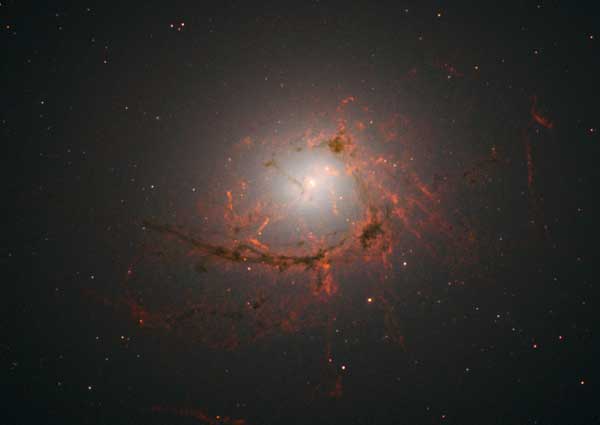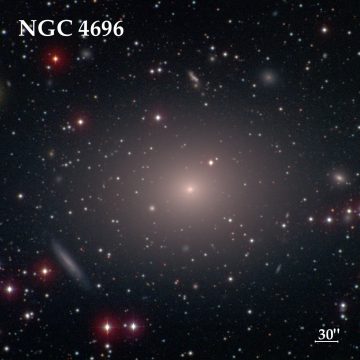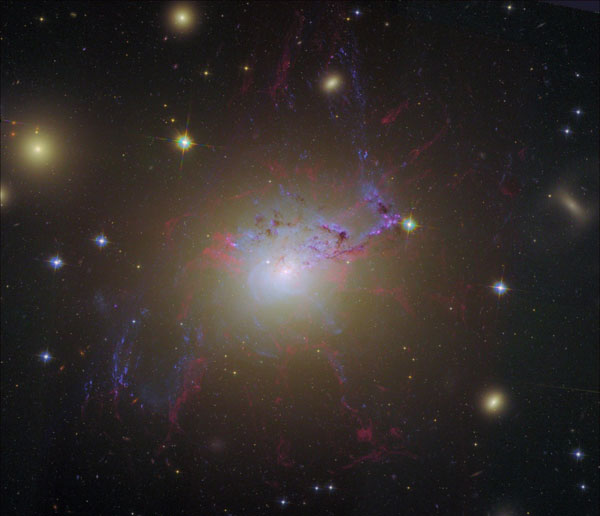A Hubble image of a nearby, massive elliptical galaxy (NGC 4696) reveals tenuous filaments that appear to be connected to the growth of the galaxy's supermassive black hole.
The latest Hubble Space Telescope image of the huge and unusual elliptical galaxy, NGC 4696, has revealed in greater detail than ever before the intricate web of hot, glowing gas across a 30,000 light-year region near the galaxy’s core. The close-up look at these gossamer gas filaments is helping astronomers understand the dynamics that occur around the supermassive black holes chowing down on gas.

NASA / ESA / Hubble / A. Fabian
The Tangled Threads within NGC 4696
NGC 4696 is a bright and massive galaxy at the center of the Centaurus cluster, 150 million light-years from Earth. It’s also an active galaxy, its brightness powered by a supermassive black hole lurking in its heart.
The region shown above has been of interest to astronomers for decades. Elliptical galaxies are typically amorphous, featureless, and nearly spherical assemblages of stars, devoid of spiral arms and, often, recent star formation. Early on astronomers discovered that NGC 4696 possesses a massive dust lane arcing across its nucleus. Later images revealed the even more intricate nebulosity present in this central region. These curious features have made NGC4696 an object of great interest to astronomers.

Carnegie-Irvine Galaxy Survey
Hubble last imaged NGC4696 in 2010. Now, this new look zooms in on the central part of the galaxy. The image reveals, in finer detail than ever before, the 30,000-light-year-long dust lane crossing the galaxy’s face, as well as the more recently discovered threads of glowing nebulae woven throughout the region.
Each filament of hot, glowing gas in this image is about 200 light-years across. Astronomers believe that the filaments themselves may consist of many even smaller threads.
Striking in their shape and extent, these delicate strands are 100 times longer than they are wide, and yet they live dangerously close (in cosmic terms) to the heart of an active galaxy.
Survival of the Filaments
The supermassive black hole at the center of NGC 4696 doesn’t just consume a lot of matter; it also belches out a lot of energy in the form of jets. These jets inflate bubbles filled with energetic particles that balloon out thousands of light years. The bubbles ought to have expanded through the volume that contains the filaments. Why doesn’t the expanding wake of energy shred them, dispelling their material throughout the galaxy?
It could be that the radio bubbles, despite their seemingly inhospitable environments, actually create filaments. The bubble’s magnetic fields appear to be channeling hot gas into narrow regions. Then as the bubbles expand away from the galaxy’s center, the channels of gas stretch out like taffy.
Andrew Fabian (Cambridge University, UK) and colleagues saw a similar situation in NGC 1275, a bright elliptical galaxy that also features radio bubbles and filaments within them. NGC 1275 sits at the center of the Perseus Cluster. The filament-creating process may be common to the bright, central members of galaxy clusters.

Image: Hubble Legacy Archive / ESA / NASA, Processing: Al Kelly
Future Study
“What would be even more interesting would be to resolve the structure near the supermassive black hole," says Julie Hlavacek-Larrondo (University of Montreal, Canada), who also studies supermassive black hole feedback. "Is the swirl still present on smaller scales? How far down do filaments go? Down to the black hole?"
Luckily, NGC 4696 is particularly well-suited for such study. Because it’s much closer than other massive ellipticals, sharper images of filaments and other structures close to the heart of its central black hole will no doubt shed new light on the dynamics of radio bubbles and glowing gas filaments in massive elliptical galaxies.
 0
0









Comments
You must be logged in to post a comment.